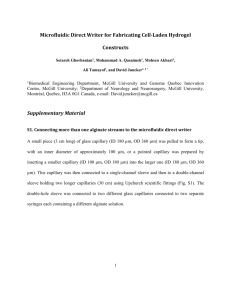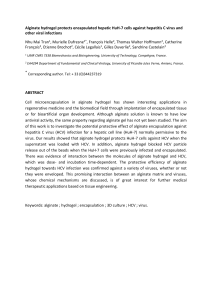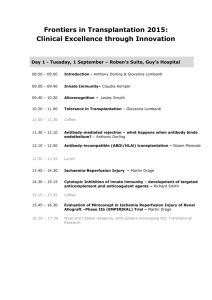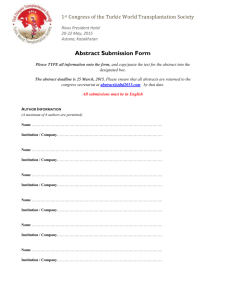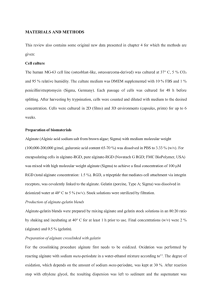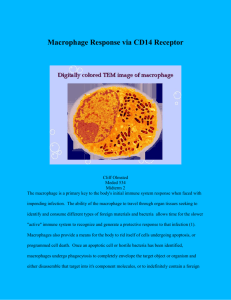molecular mechanims for cell activation within the innate immune
advertisement
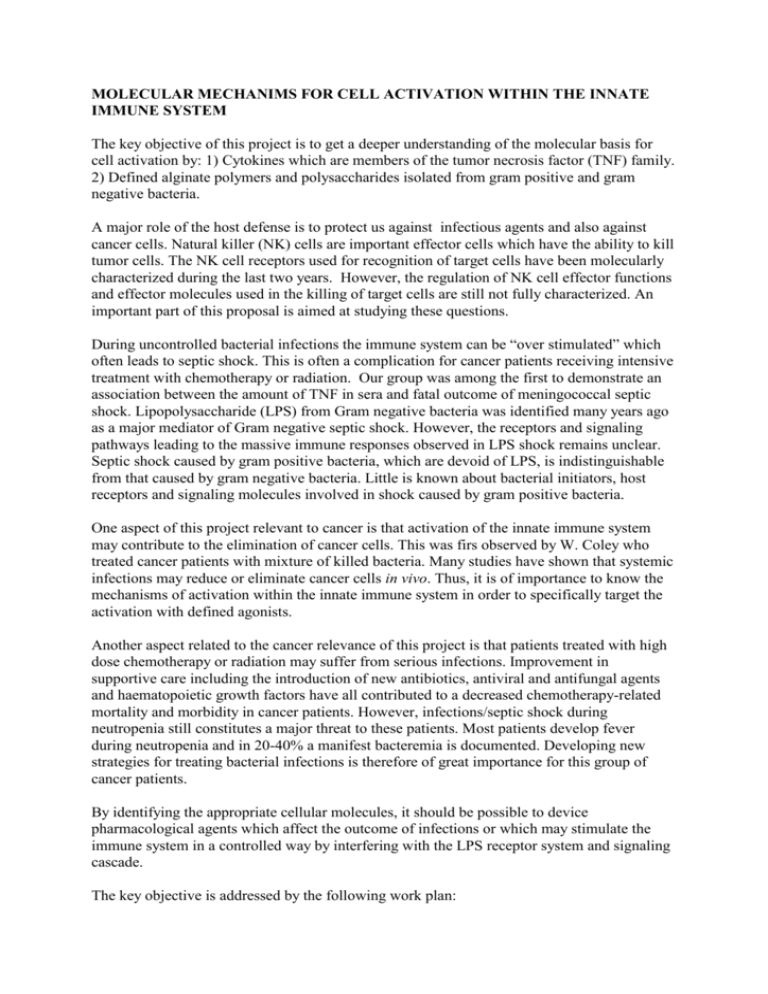
MOLECULAR MECHANIMS FOR CELL ACTIVATION WITHIN THE INNATE IMMUNE SYSTEM The key objective of this project is to get a deeper understanding of the molecular basis for cell activation by: 1) Cytokines which are members of the tumor necrosis factor (TNF) family. 2) Defined alginate polymers and polysaccharides isolated from gram positive and gram negative bacteria. A major role of the host defense is to protect us against infectious agents and also against cancer cells. Natural killer (NK) cells are important effector cells which have the ability to kill tumor cells. The NK cell receptors used for recognition of target cells have been molecularly characterized during the last two years. However, the regulation of NK cell effector functions and effector molecules used in the killing of target cells are still not fully characterized. An important part of this proposal is aimed at studying these questions. During uncontrolled bacterial infections the immune system can be “over stimulated” which often leads to septic shock. This is often a complication for cancer patients receiving intensive treatment with chemotherapy or radiation. Our group was among the first to demonstrate an association between the amount of TNF in sera and fatal outcome of meningococcal septic shock. Lipopolysaccharide (LPS) from Gram negative bacteria was identified many years ago as a major mediator of Gram negative septic shock. However, the receptors and signaling pathways leading to the massive immune responses observed in LPS shock remains unclear. Septic shock caused by gram positive bacteria, which are devoid of LPS, is indistinguishable from that caused by gram negative bacteria. Little is known about bacterial initiators, host receptors and signaling molecules involved in shock caused by gram positive bacteria. One aspect of this project relevant to cancer is that activation of the innate immune system may contribute to the elimination of cancer cells. This was firs observed by W. Coley who treated cancer patients with mixture of killed bacteria. Many studies have shown that systemic infections may reduce or eliminate cancer cells in vivo. Thus, it is of importance to know the mechanisms of activation within the innate immune system in order to specifically target the activation with defined agonists. Another aspect related to the cancer relevance of this project is that patients treated with high dose chemotherapy or radiation may suffer from serious infections. Improvement in supportive care including the introduction of new antibiotics, antiviral and antifungal agents and haematopoietic growth factors have all contributed to a decreased chemotherapy-related mortality and morbidity in cancer patients. However, infections/septic shock during neutropenia still constitutes a major threat to these patients. Most patients develop fever during neutropenia and in 20-40% a manifest bacteremia is documented. Developing new strategies for treating bacterial infections is therefore of great importance for this group of cancer patients. By identifying the appropriate cellular molecules, it should be possible to device pharmacological agents which affect the outcome of infections or which may stimulate the immune system in a controlled way by interfering with the LPS receptor system and signaling cascade. The key objective is addressed by the following work plan: Study expression, functions of FasL/Fas, Apo2L/Apo-2 in relation to NK cell activities . Assess the role of CD14, ß2 integrins and LPS/CD14 signal transducers in cell activation induced by LPS and polysaccharides from gram positive bacteria (Group B Streptococci) and defined uronic acid polymers, To clone the putative signal transducer(s) recognized by LPS/CD14. In this project we are addressing the newly described Toll receptors which have been shown to be involved in innate immunity in Drosophila . The hypothesis is that different bacterial polysaccharides may use different Toll receptors in activating immune cells. BIOCOMPATIBLE ALGINATE CAPSULES FOR TRANSPLANTATION OF CELLS The use of alginate capsule technology to treat diabetes: Insulin dependent diabetes mellistus (IDDM, also called type I diabetes) is regarded as an autoimmune disease which results in destruction of the insulin producing ß-cells of the pancreas. Despite for insulin therapy, many IDDM patients may develop complications such as: unawareness of hypoglycaemia, nephropathy, neuropathy and retinopathy. One alternative treatment of IDDM is to provide the patient with insulin producing tissue by transplantation. Whole pancreas or islet transplantation is the only treatment to achieve and maintain long-term normoglycemia, whithout the need for exogenous insulin treatment. However, the transplanted tissue will be susceptible to immune-mediated destruction if the recipient is not given immunosuppresion. Whole pancreas transplantation alone is a complicated surgical procedure and is only given to a limited numbers of IDDM patients. Transplantation of only the pancreatic islets seems to be an attractive approach since it does not require major surgery. However, the current success rate of islet transplantation in man is low, only 10 % of the transplanted patients have become independent of exogenous insulin treatment for a limited time period after the transplantation. Insufficient immunoprotection of the islets is one of the causes of the limited success of this procedure. Another obstacle is the currently limited supply of human pancreas, and the fact that two or three pancreas are necessary to obtain enough islets for one transplantation. One way to sole this problem is to use islet from porcine, which in principle represents a large source of cells. However, the use of xenotransplantation may require a stronger immunebarrier around the transplantate. In addition, the possibility of virus transmission from donor to the recipient must be evaluated. Alginate isolated from Norwegian seaweed has become one of the most useful and flexible immobilisation material for living cells. The most exciting prospects for alginate immobilised cells are their potential use for transplantation where the object of the gel matrix or capsule membrane is to serve as an immunebarrier between the transplant and the immunesystem of the host. A range of cells have been suggested , including parathyroid cells for treatment of hypocalcemia, dopamine producing cells for treatment of Parkinsons disease, as well as hepatocytes for treatment of liver failure. Major interest has, however, been devoted to insulin producing cells for the treatment of Type I diabetes. Since 1989 we have been involved in designing alginate based microcapsules enholding pancreatic islets. Although the method was described more than 15 years ago it is only recently that these capsules have been shown to reverse diabetes in large animals. The use of alginate capsule technology to treat gliomas: In Norway there are around 300400 new cases of primary brain tumours (gliomas) each year. These gliomas constitute around 50% of the total number of intracranial tumours where the malignant forms have a very bad prognosis with a mean survival of around 1 year. Despite intensive research the treatment of patients with gliomas has not improved during the last 40 years and the survival rate after treatment has not increased. Thus, there is a demanding need for new therapy for this disease. During the last 10 years recombinant gene technology has made it possible to transfect cells with genes encoding proteins which may suppress the growth and development of the gliomas. The use of these cells for transplantation purposes has been hampered by immunemediated destruction of the cells. This can be solved by encapsulating these production cells in alginate. The aim is to develop a biological therapy system which consists of different types of producer cells encapsulated in alginate. Our group has established a collaboration with professor Rolf Bjerkvig who has a been working with experimental animal models for gliomas for several years. This part of the project will be conducted in close collaboration with his group in Bergen. Implications of the results from this project: The results from this project should give important information on how to construct and produce biocompatible alginate capsules which can be used for allo- and xeno transplantation. This technology may provide new treatments for insulin dependent diabetes mellitus as well as for malignant gliomas. The project has significant industrial potential in particular for the production of alginate for biomedical applications (Pronova Biopolymers). Some recent papers: 1997: 134. Jahr TG, Ryan L, Sundan A, Lichenstein HS, Skjåk-Bræk G, Espevik T: Induction of Tumor necrosis factor production from monocytes stimulated with mannuronic acid polymers and involvement of lipopolysaccharide-binding protein, CD14, and bactericidal/permeability-increasing factor. Infect Immun 65:89-94, 1997. 135. Medvedev A, Johnsen A-C, Haux J, Steinkjer B, Egeberg K, Lynch DH, Sundan A, Espevik T. Regulation of Fas and Fas-Ligand expression in NK cells by cytokines and the involvement of FasLigand in NK/LAK cell-mediated cytotoxicity. Cytokine 9(6):394-404,1997. 136. Espevik T, Skjåk-Bræk G: Particle-bound polysaccarides and nucleic acids for immune stimulation. Patent Application, May 1997. 137. Halaas Ø, Olsen WM, Veiby OP, Løvhaug D, Skjåk-Bræk G, Vik R, Espevik T: Mannuronan enhances survival of lethally irradiated mice and stimulates murine hepatopoiesis in vitro. Scand J Immunol 46: 358-365, 1997. 138. Jackson AM, Lien E, Alexandroff AB, Prescott S, Espevik T, James K, Selby PJ, Sundan A: Soluble urinary CD14 after intravesical bacille Calmette-Guérin immunotherapy for carcinoma in situ. British J Urol 80:766-771, 1997. 139. Aukrust P, Hestdal K, Lien E, Bjerkeli V. Nordøy I, Espevik T, Müller F, Frøland S. Effects of intravenous immunoglobulin in vivo on abnormally increased tumor necrosis factor activity in human immunodeficiency virus type 1 infection. J Infect Dis 176(4); 913-923, 1997. 140. Kulseng B, Thu B, Espevik T, Skjåk-Bræk G: Alginate polylysine microcapsules as immune barrier: permeability of cytokines and immunoglobulins over the capsule membrane. Cell Transplant 6(4):387394,1997. 141. Hestdal K, Aukrust P, Müller F, Lien E, Bjerkeli V, Espevik T, Frøland SS. Dysregulation of membranebound tumor necrosis factor- and tumor necrosis factor receptors on mononuclear cells in human immunodeficiency virus type 1 infection: low percentage of p75-tumor necrosis factor receptor positive cells in patients with advanced disease and high viral load. Blood 90(7):2670-2679, 1997. 1998, In press and submitted: 142. Lien E, Sundan A, Aukrust P, Frøland SS, Espevik T. Elevated levels of serum soluble CD14 in HIV-1 infection. Blood. 1998 Sep 15;92(6):2084-92. 143. Stenvik J, Lien E, Jahr TG, Espevik T. Detection of TNF in monocytecultures and in sepsis sera with bioand immunoassays - differences related to TNF and TNF-soluble TNF receptor complexes. To be submitted. 144. Lægreid A, Lien E, Medvedev A, Sundan A, Espevik T. Effect of different inhibitors on TNFR membrane expression and release of soluble TNFR from SW480 -gal coloncarcinoma cell line. Submitted. 145. Berntzen G, Flo T, Medvedev A, Kilaas L, Sundan A, Skjåk-Bræk G, Espevik T. Increasing the TNF inducing potency of uronic acid polymers and polysaccharides from LPS by covalently linkage to beads. Clin Diagn Lab Immunol. 1998 May;5(3):355-61. 146. Thommesen L, Sjursen W, Gåsvik K, Hanssen W, Brekke OL, Skattebøl L, Holmeide AK, Espevik T, Johansen B, Lægreid A. Selective inhibitors of cytosolic or non-pancreatic phospholipase A2 block tumor necrosis factor induced activation of transcription factor NKB and expression of ICAM-1. J Immunol. 1998 Oct 1;161(7):3421-30. 147. Halaas Ø, Vik R, Espevik T. Induction of Fas ligand in murine bone marrow NK-cells by bacterial polysaccharides. Immunol. 1998 May 1;160(9):4330-6. 148. Haux J, Johnsen A-C, Steinkjer B, Egeberg K, Sundan A, Espevik T. The role of IL-2 in regulating the sensitivity of NK cells for Fas-mediated apoptosis. Submitted to J. Immunol. 149. Kulseng B, Skjåk-Bræk G, Espevik T: Soluble tumor necrosis factor receptors in sera from patients with insulin dependent diabetes mellitus: correlations with duration of disease and complications. Submitted to Acta Diabetologica. 150. Medvedev AE, Vogel SN, Robin R, Golenbock DT, Teti G, Espevik T: Involvement of CD14 and CD18/CD11B in NF-B activation and TNF- production induced by lipopolysaccharide and group B streptococci type III. J Immunol. 1998 May 1;160(9):4535-42. 151. Rokstad AM, Espevik T, Skjåk-Bræk G, Vadstein O: Induction of superoxide anion production in Atlantic salmon (Salmo salar L.).Macrophages after treatment with poly mannuronic acid poly M) or lipopolysaccharide (LPS) and the involvement of serum. In preparation. 152. Kulseng B, Gåserød O, Espevik T, Skjåk-Bræk G: Alginate-polylysine microcapsules made by a high voltage electrostatic system, govering parameters and properties. Submitted to J. Encapsulation. 153. Flo TH, Skjåk-Bræk G, Sundan A, Espevik T: CD14 and CR3 on monocytes are involved in the TNF production induced by detoxified LPS and mannuronan covalently attached to particles. In preparation. 154. Aukrust P, Ueland T, Lien E, Bendtzen K, Müller F, Andreassen AK, Nordøy I, Aass H, Espevik T, Simonsen S, Frøland SS, Gullestad L: The cytokine network in congestive heart failure - dysbalance between inflammatory and anti-inflammatory mediators. Circulation, In press 155. Kulseng B, Skjåk-Bræk G, Ryan L, Andersson A, King A, Faxvåg A, Espevik T: Transplantation of alginate microcapsules: generation of antibodies against alginate and encapsulated porcine islet-like cell clusters. Transplantation, In press. 156. Johnsen AC, Haux J, Egeberg K, Sundan A, Ashkenazi A, Espevik T: Induction of Apo-2L/TRAIL in NKcells - involement in NK-mediated cytotoxicity. Submitted to Cytokine. 157. Cuzzola M, Mancuso G, Beninati C, Cusumano V, Hunolstein C, Orefici G, Espevik T, Teti G: (CD18/CD11) is involved in TNF responses of human monocytes to group A and group B streptococci. In preparation. 158. Kulseng B, Espevik T and Sundan A. Increased levels of HGF in patients with insulin diabetes mellitus. Acta Diabetol. 1998 Jul;35(2):77-80. CR3 dependent 159. Robin R. Ingalls*†, Brian Monks*, Ricardo Savedra, Jr.*, William J. Christ‡, Russell L. Delude§, ¶ || ¶ Andrei E. Medvedev , Terje Espevik and Douglas T. Golenbock*. CD11/CD18 and CD14 share a common lipid A signaling pathway 1 Submitted to J. Immunol. 160. Aukrust P, Haug CJ, Ueland T, Lien E, Muller F, Espevik T, Bollerslev J, Frøland S. Decreased formation and enhanced resorptive markers in HIV infection - indication of normalization of the bone remodelling process during highly active antiretroviral therapy. Journal of Clinical Endocrinology and Metabolism, In press. 161. Aukrust P, Müller F, Lien E, Nordøy I, Liabakk N-B, Kvale D, Espevik T and Frøland SS. Tumor necrosis factor (TNF) system in HIV-infected patients during highly active antiretroviral therapy (HAART) persistent TNF activation predicts virologic and immunologic treatment failure. Journal of Infectious Diseases, In press.


